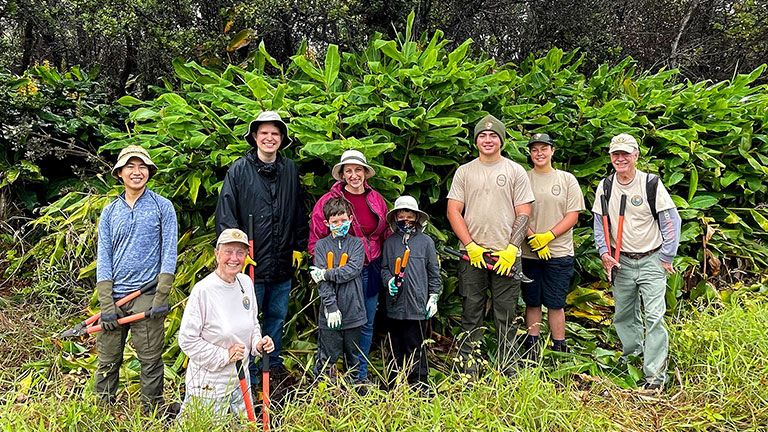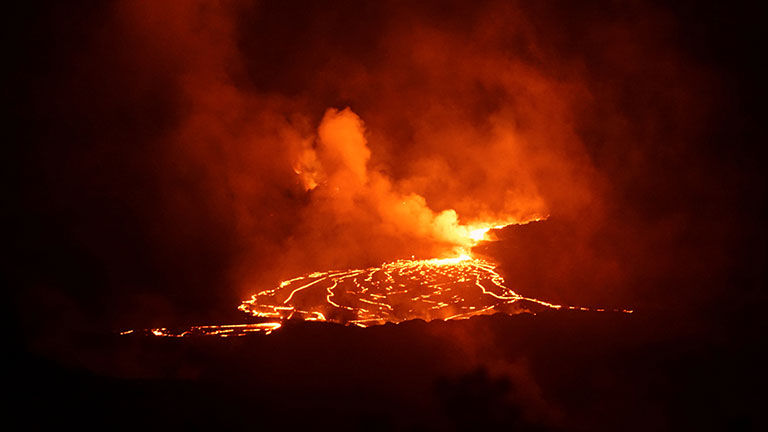For nearly a decade, Paul Field and his wife, Jane, have been removing invasive plants from the native rainforest in Hawaii Volcanoes National Park, an ongoing conservation effort for which Hawaii Island vacationers regularly volunteer.
“They’re absolutely essential,” said Paul Field of the visitors who have helped out over the years. “Jane and I go out and work a lot, but there are only two of us, and we’re not particularly young. The only way it can really work is when you get more hands out there. Then you really get more done.”
Retired university professors, the Fields moved to Hawaii Island from Oahu in 2013, and began volunteering in the national park soon after. It didn’t take them long to see how invasive plant species — particularly Himalayan ginger — had a disturbing foothold at different locations throughout the park’s rainforest, making it difficult for native Hawaiian plants to grow.
According to park officials, Himalayan ginger was first introduced to Hawaii Volcanoes National Park in the 1940s as a decorative plant around some of the park’s residential housing. It spread quickly due to birds eating and then dispersing the plants’ seeds in their droppings.
“They sometimes call the forest here an ‘upside-down rainforest’ because the greatest variety is on the forest floor — in South America, much of the diversity is in the canopy,” Paul Field explained. “But when the ginger moves in here, it totally shades out the native understory, and it’s a nutrient and water hog, so all the native plants that should be in the understory gradually disappear.”
 Volunteers can work with Paul Fields (far right) and his wife Jane (kneeling) to remove invasive plants from the native rainforest in Hawaii Volcanoes National Park.
Volunteers can work with Paul Fields (far right) and his wife Jane (kneeling) to remove invasive plants from the native rainforest in Hawaii Volcanoes National Park.
Credit: 2022 Hawaii Volcanoes National Park/J.WeiEventually, that thick ginger growth would mean the end of new native flora like ohia lehua trees (flowering evergreens) and midstory trees (the intermediate canopy layer), he added.
The Fields decided to help get rid of as many invasive species as they could, and proposed a volunteer program to park officials. In late 2013, in partnership with the national park, they launched Stewardship at the Summit, inviting residents and visitors to work as individuals or small groups alongside them on a weekly schedule to remove invasive plants from the forest floor.
Making an Immediate Impact
Typically, the volunteer activity takes place Friday and Saturday mornings, when participants meet with the Fields at the park’s Kilauea Visitor Center for a brief orientation. Folks then follow the couple out to the morning’s work site, which usually involves a brief drive and a short hike into the rainforest.
The Fields provide work gloves and trimming tools, and volunteers are encouraged to wear sunscreen, long sleeves and pants. Bringing snacks and water is also a good idea, as the sessions last about three hours — but the Fields plan for frequent breaks, and the work usually takes place in the shade.
If you just come to visit, you’ll see the forest, but you won’t know anything about it. The people who come but also go out and work with us leave with a real appreciation for the forest.
“It actually gets visitors out into the forest,” Paul Field said. “If you just come to visit, you’ll see the forest, but you won’t know anything about it. The people who come but also go out and work with us leave with a real appreciation for the forest.”
Volunteers not only provide much-needed manpower; they also share their experiences about the conservation effort with friends and family back home, spreading the word in a meaningful way, Jane Field noted.
“And they come back,” she said. “We have a number of volunteers we see once a year when they make an annual trip to the islands.”
During a Hawaii Island visit earlier this year, I joined the Fields, some local residents and some vacationers from the Pacific Northwest to work on an especially entrenched grove of Himalayan ginger located about a 15-minute drive from the park’s visitor center.
Although it wasn’t especially difficult work — cutting the tall, broad-leafed ginger stocks with loppers and then piling up the leafy branches as we progressed — it was remarkable how much we cleared in just a few hours. And the small area of forest where we worked was unmistakably transformed by the time the Fields decided we had done enough for the day.
“It’s such wonderful reinforcement to see that the work you’re doing is making a real difference in the forest right now,” said Jane Field, who noted that volunteers have spent more than 13,500 hours removing invasive plants from the national park with Stewardship at the Summit since the program’s launch. “A lot of people know how endangered these areas are, but they don’t realize that if you put in a little elbow grease, it will be less endangered. And there really is a chance for these sections of native forest to survive and thrive.”
Accommodations Near Hawaii Volcanoes National Park
Just a five-minute drive from the main entrance to Hawaii Volcanoes National Park is Volcano Village Estates, a collection of modern bungalows and a larger residence that dates back to the 1930s. The accommodations offer travelers a wonderfully situated launching point from which to enjoy the park's hiking opportunities and unique natural wonders.
 Volcano Village Estates offers Hawaii Island visitors high-end accommodations one mile from the entrance to Hawaii Volcanoes National Park.
Volcano Village Estates offers Hawaii Island visitors high-end accommodations one mile from the entrance to Hawaii Volcanoes National Park.
Credit: 2022 Volcano Village EstatesFormerly Hale Ohia, the property reopened as a bed and breakfast in May 2021 under new management. All the guestrooms and their ensuite bathrooms have since received significant soft goods upgrades, according to Pua Norris, head innkeeper for Volcano Village Estates.
Norris also noted that, like many accommodations throughout the Hawaiian Islands, business has been booming in 2022.
“Even during the normally slow months of February and March, we were really booked, which was wonderful for us,” she said.
Commissionable to travel advisors, room rates range from about $250 to $450 per night for the comfortably appointed high-end bungalows, which are great for vacationing couples. But the bed and breakfast also offers a number of larger options that can house traveling families and friend groups, including the historic Dillingham Residence that sleeps five adults and features a large living/dining room with a fireplace, and the Akaka Falls guesthouse, which also sleeps five and is equipped with a full kitchen. According to Norris, most guests stay three to four nights, since they’re typically keen to see as much as they can within the nearby national park.
During my two-night stay, I found that the bed and breakfast’s location made it terrifically easy to clean up after a morning of removing invasive ginger with the Fields, then return to the park in the afternoon for some rainforest hiking.
Easy Lava Viewing
Staying at Volcano Village Estates also makes it easy to avoid crowds at Hawaii Volcanoes National Park’s most popular lava viewing site. The overlook near Keanakakoi Crater is open 24 hours and often extraordinarily busy from 5 to 9 p.m. — especially on weekends. But when I arrived there around midnight on the first night of my stay, it was virtually deserted.
 Visitors hoping to avoid crowds at lava viewing sites may want to consider late-night trips to the Keanakakoi Crater overlook.
Visitors hoping to avoid crowds at lava viewing sites may want to consider late-night trips to the Keanakakoi Crater overlook.
Credit: 2022 Shane NelsonPast experience has taught me that late-night visits improve your chances of enjoying the remarkable eruption sites within the national park’s Kilauea Caldera without the crowds, and may even mean you get the show all to yourself. It was a tremendous experience to be out under a sky full of stars, listening to the unmistakable sound of the distant eruption — a roaring much like a jet airplane engine — while molten rock fountained up occasionally under the glowing orange cloud of volcanic steam and gas, splattering the surrounding black rock with luminescent red freckles.
And, thanks to the location of my Volcano Village Estates bungalow just outside the park entrance, I was in bed and asleep only a short while later.
“We’re a mile away,” Norris said. “How can you beat that?”